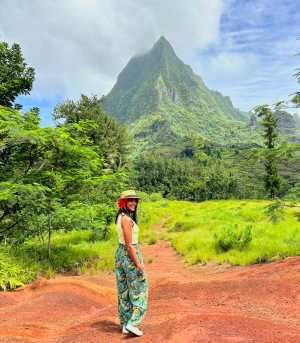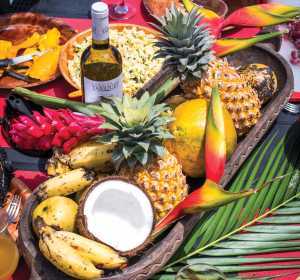"You must float in this water, trust me,” nudges my enthusiastic tour guide, Yvette Leon. She cradles my body from below the surface of swirling water, turning me towards the apex of a waterfall gushing before me.
“Let the water run over you — feel the mana,” she says, releasing me into the forceful power of the cataract. “This water is healing. These lands are sacred. Let the mana wash over you,” she repeats.
The sacred lands she’s referring to are Afareaitu, a Tahitian word that translates into the sacred valley of gods and kings, on Mo‘orea. This island is the second largest of the Îles du Vent (Windward Islands) in the Society Islands of French Polynesia, in the central South Pacific Ocean. Mo‘orea was born from the remains of an ancient half-eroded volcano that lies 20 km northwest of Tahiti.

Writer Charmaine Noronha explores Mo'orea on a guided tour
Mo‘orea is mystical. Magical. Serene. It’s tranquil. It feels like one of the last undisturbed havens in the world. And the draw here is an otherworldly energy that permeates the island. It resonates from Mo‘orea’s jagged majesty — volcanic rocks form these land masses, whose lush emerald hills blanket the island in gradients of striking greenery. You feel it through the forceful tropical winds that attempt to whisk you away without warning under brooding clouds. It emanates from breathtaking waterfalls that dot the island, and from the ocean and lagoons, the paradisiacal colour of what honeymoon dreams are made of. It lives in the fertile volcanic soil that produces the island’s nutrient-rich, delicious food. It’s a palpable sacred life force known here as mana.
“Mana is the energy of nature,” says the effervescent Leon, who runs a company called Moorea VIP Tours, which leads cultural and historical experiences around the lush island.
Mana is unequivocally central to many cultures in French Polynesia, celebrated by the island’s Indigenous people via the tattoos that adorn their bodies, and in the emotive dances they perform in traditional dress.
“It’s what makes us, us, and what makes this island so special,” says Leon as she guides me through a muddy, and at times precarious, hike to reach the stunning cascade of water, the Waterfalls d’Afareaitu in Tupauru’uru, Mo‘orea.
We pass by the Belvédère d’Opunohu. Located 240 metres above sea level, in the heart of the island, it overlooks Opunohu and Cook, the two bays of Mo‘orea separated by the famous Mount Rotui peak.

The inhabitants of Mo‘orea incorprorate plenty of fresh fruit into diets
Meandering through pineapple fields, we spy the island’s three main mountains: Mont Rotui, Mou‘a puta and Mou‘a roa. The peaks are visible from several vantage points, standing tall before the bluest of lagoons in the crater at the centre of Mo‘orea.
The peaks provide a glorious backdrop to the island’s Pineapple Trail. Mo‘orea is well-known in French Polynesia as the pineapple centre of the archipelago, where the fruit flourishes thanks to the island’s rich volcanic soil, abundant rainfall and a magical mana that ensures extraordinary flavour.
“Cultivating pineapples is a very precise affair,” says Leon. “The plant blooms with a blue flower which slowly turns into a fruit over the next few months. Then you have to wait until the fruit is fully ripe because pineapples don’t ripen once they’re picked.”
Leon says it takes about a year from planting to harvest, and the more the fruit is exposed to sunshine, the sweeter it becomes, which is why the pineapples of Mo‘orea are so delicious.
The Sofitel Kia Ora Moorea Beach Resort resort sits on the island’s longest beach
Grégoire Le Bacon
When checking into my hotel, the stunning Sofitel Kia Ora Moorea Beach Resort, which cradles the edge of a crystal-clear lagoon framed by jagged green mountains, I’m greeted with a welcome pineapple juice.
Pineapples here are best served raw, and are commonly sliced in a fruit salad or cubed as a topping for sorbets and ice cream. Mo‘orea pineapples are also distilled and used in wine or as a sweetener in cocktails. In addition to raw preparations, they can be grilled and served in meat or rice dishes. The Rotui Juice Factory & Distillery makes the sweet fruit into jams and jellies, as well as juice that can be found all over the island.
On the pineapple trail, we pass rich scenery with magnificent panoramic views, especially over Mount Rotui and Mou‘a puta.
“Mou‘a puta means ‘pierced mountain’ and was named after the legend of the warrior Hiro who allegedly pierced the mountain with his spear,” says Leon. “We have many legends and ancient stories. There are many special places here.”
Grégoire Le Bacon
For Leon, mana is also very present in the food. It can be felt in the freshness of the island’s national dish, poisson cru. Diced, melt-in-your-mouth, raw fish — usually red tuna — and veggies are soaked in coconut milk and marinated with lime juice. It’s divinely delicious and simple to prepare.
Poisson cru au lait de coco translates to “raw fish in coconut milk.” Similar to Hawaiian poke or Latin American ceviche, it uses lime juice as an acidic “cooking” agent, but the main difference is the coconut milk, a significant component of the dish’s definitive delectable taste.
Also unique is poisson cru à la Chinoise, made with the addition of ginger, pickled cucumbers and Chinese white vinegar. Raw fish isn’t commonly consumed in traditional Chinese cuisine, but on the islands of Tahiti, this dish is on almost every Chinese restaurant menu.
Mo'orea's national dish, poisson cru is made with raw fish and coconut milk
Danee Hazama
Chinese influence in the local cuisine started in the second part of the 19th century, when the majority of the first Chinese immigrants arrived in Tahiti. Mostly from the Hakka community, the settlers slowly blended into Tahitian society, and their food adapted to the local ingredients, becoming an essential part of Polynesian meals. On Mo‘orea, traditional Chinese food started to become much sweeter, and incorporated thicker sauces for the Tahitian palate, while Tahitians embraced Chinese condiments such as plum sauce and Shaoxing wine when cooking at home.
Along with the Chinese variation of poisson cru, the most famous fusion dishes are the local version of the stir-fried noodles, chao mein; and ma‘a tinito haricot rouge, twice-cooked pork with red beans. The dishes are usually very affordable and served everywhere, from food trucks to local restaurants and hotels. Locals eat Chinese food for any occasion, but especially during Lunar New Year, which is celebrated in French Polynesia.
Grégoire Le Bacon
Leon, who is of Chinese descent, was born in Nuku Hiva, in the Marquesas Islands. She grew up on Tahiti and then studied tourism in Aix-en-Provence in the South of France. She’s a walking encyclopedia when it comes to the history and culture of Mo‘orea. She leads our tour past the rippled trunks of ever-reaching banyan trees and bright pops of coral hibiscus flowers to a stone structure that resembles the foundation of a building.
The rocks are stacked with the precision of modern-day masonry, but the crumbling moss-covered Marae Ti’i-rua is a symbol of ancient life. Significant archaeological and cultural sites, the marae are remnants of stone temples, where the island’s original inhabitants, the Maohi, gathered to meet, pray and honour their chiefs.
The mana of an ancient civilization permeates this place, and I still feel it, even as we sit down to enjoy the lunch that Leon has made for us. She pairs it with Tahitian noni juice, touted as a cure-all medicinal drink that is said to help with everything from skin problems and signs of aging to gout and inflammation.
Noni is a wild fruit that's rich in nutrients; its juice is a cure-all medicinal drink
Grégoire Le Bacon
Noni is one of the most prevalent wild fruits in French Polynesia. With amphibian-like skin, and covered in bumpy wart-like growths, the green, yellow or white oblong fruit isn’t the prettiest and has a very strong odour. Noni is rarely eaten in its natural fruit form; its puree is mixed with other juices such as grape or blackberry to make it more palatable. The fruit contains potassium, calcium, vitamin C and niacin. Many holistic practitioners praise it for having a higher antioxidant level compared to other fruit juices.
“This is all part of it, nature gives us healthy fruits, vegetables and fish, which fill you with energy — mana,” says Leon as she serves us poisson cru in generous helpings.
With each mouthwatering mouthful, my mana feels abundant gratitude for this mana of Mo‘orea.
